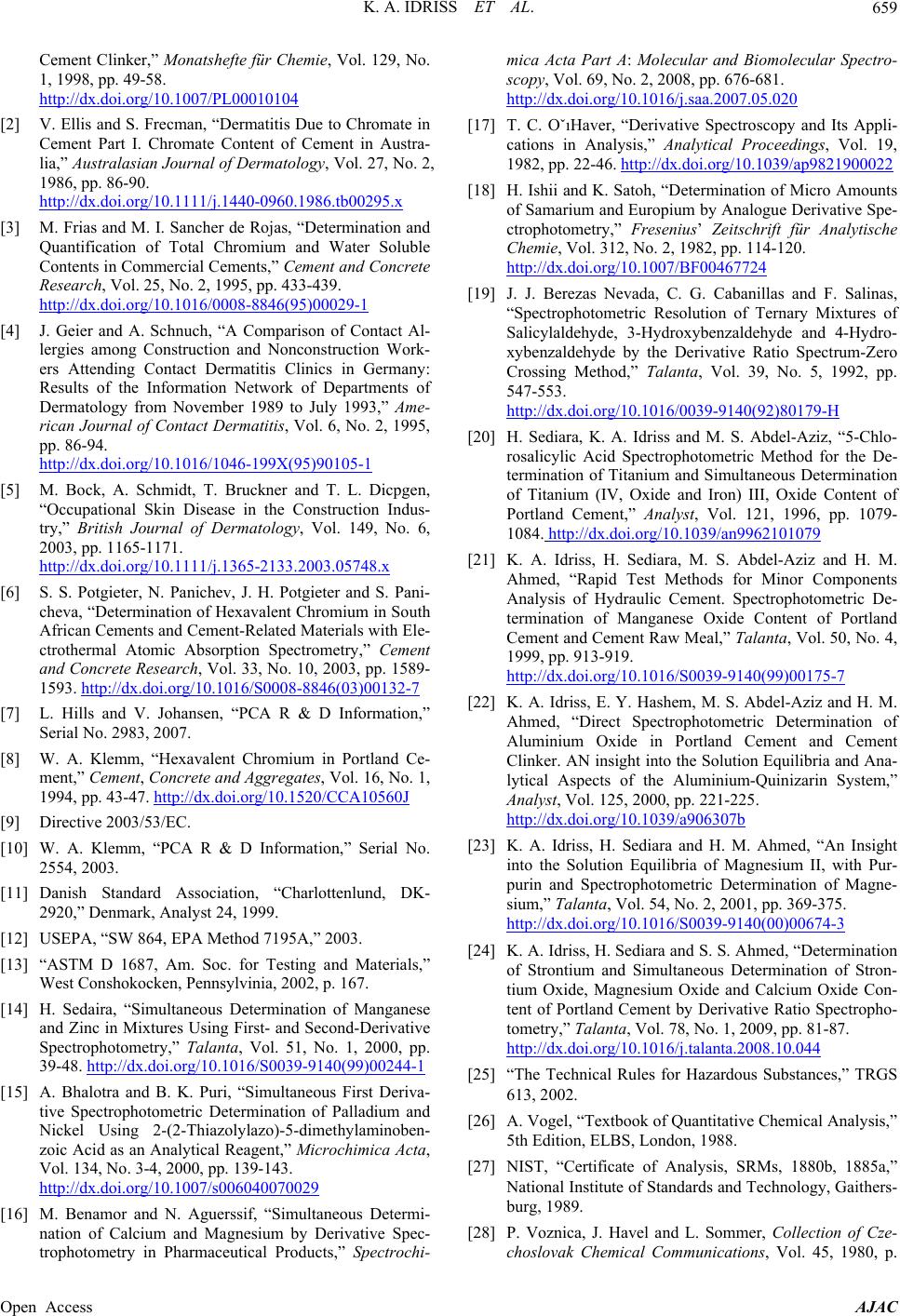
K. A. IDRISS ET AL. 659
Cement Clinker,” Monatshefte für Chemie, Vol. 129, No.
1, 1998, pp. 49-58.
http://dx.doi.org/10.1007/PL00010104
[2] V. Ellis and S. Frecman, “Dermatitis Due
Cement Part I. Chromate Content of C
to Chromate in
ement in Austra-
lia,” Australasian Journal of Dermatology, Vol. 27, No. 2,
1986, pp. 86-90.
http://dx.doi.org/10.1111/j.1440-0960.1986.tb00295.x
[3] M. Frias and M. I. Sancher de Rojas, “Determination and
Quantification of Total Chromium and Water Solub
le
Contents in Commercial Cements,” Cement and Concrete
Research, Vol. 25, No. 2, 1995, pp. 433-439.
http://dx.doi.org/10.1016/0008-8846(95)00029-1
[4] J. Geier and A. Schnuch, “A Comparison of Contact Al-
lergies among Construction and Nonconstruction
Work-
ers Attending Contact Dermatitis Clinics in Germany:
Results of the Information Network of Departments of
Dermatology from November 1989 to July 1993,” Ame-
rican Journal of Contact Dermatitis, Vol. 6, No. 2, 1995,
pp. 86-94.
http://dx.doi.org/10.1016/1046-199X(95)90105-1
[5] M. Bock, A. Schmidt, T. Bruckner and T. L. Dicpgen,
“Occupational Skin Disease in the Construction Indus-
try,” British Journal of Dermatology, Vol. 149, No. 6,
2003, pp. 1165-1171.
http://dx.doi.org/10.1111/j.1365-2133.2003.05748.x
[6] S. S. Potgieter, N. Panichev, J. H. Potgieter and S. P
cheva, “Determination of Hexavalent Chromium in S
ani-
outh
African Cements and Cement-Related Materials with Ele-
ctrothermal Atomic Absorption Spectrometry,” Cement
and Concrete Research, Vol. 33, No. 10, 2003, pp. 1589-
1593. http://dx.doi.org/10.1016/S0008-8846(03)00132-7
[7] L. Hills and V. Johansen, “PCA R & D Information,”
Serial No. 2983, 2007.
[8] W. A. Klemm, “Hexavalent Chromium in Portland Ce-
ment,” Cement, Concrete and Aggregates, Vol. 16, No. 1,
1994, pp. 43-47. http://dx.doi.org/10.1520/CCA10560J
[9] Directive 2003/53/EC.
tion,” Serial No. [10] W. A. Klemm, “PCA R & D Informa
2554, 2003.
[11] Danish Standard Association, “Charlottenlund, DK-
2920,” Denmark, Analyst 24, 1999.
terials,”
rivative
[12] USEPA, “SW 864, EPA Method 7195A,” 2003.
[13] “ASTM D 1687, Am. Soc. for Testing and Ma
West Conshokocken, Pennsylvinia, 2002, p. 167.
[14] H. Sedaira, “Simultaneous Determination of Manganese
and Zinc in Mixtures Using First- and Second-De
Spectrophotometry,” Talanta, Vol. 51, No. 1, 2000, pp.
39-48. http://dx.doi.org/10.1016/S0039-9140(99)00244-1
[15] A. Bhalotra and B. K. Puri, “Simultaneous First Deriva-
tive Spectrophotometric Determination of Palladium and
Nickel Using 2-(2-Thiazolylazo)-5-dimethylaminoben-
zoic Acid as an Analytical Reagent,” Microchimica Acta,
Vol. 134, No. 3-4, 2000, pp. 139-143.
http://dx.doi.org/10.1007/s006040070029
[16] M. Benamor and N. Aguerssif, “Simulta
nation of Calcium and Magnesium by D
neous De
erivative Spec-
termi-
trophotometry in Pharmaceutical Products,” Spectrochi-
mica Acta Part A: Molecular and Biomolecular Spectro-
scopy, Vol. 69, No. 2, 2008, pp. 676-681.
http://dx.doi.org/10.1016/j.saa.2007.05.020
[17] T. C. OˇıHaver, “Derivative Spectroscopy and I
cations in Analysis,” Analytical Proceedints Appli-
gs, Vol. 19,
1982, pp. 22-46. http://dx.doi.org/10.1039/ap9821900022
[18] H. Ishii and K. Satoh, “Determination of Micro Amounts
of Samarium and Europium by Analogue Derivative Spe-
ctrophotometry,” Fresenius’ Zeitschrift für Analytische
Chemie, Vol. 312, No. 2, 1982, pp. 114-120.
http://dx.doi.org/10.1007/BF00467724
[19] J. J. Berezas Nevada, C. G. Cabanillas and
“Spectrophotometric Resolution of Ter
F. Salinas,
nary Mixtures of
Salicylaldehyde, 3-Hydroxybenzaldehyde and 4-Hydro-
xybenzaldehyde by the Derivative Ratio Spectrum-Zero
Crossing Method,” Talanta, Vol. 39, No. 5, 1992, pp.
547-553.
http://dx.doi.org/10.1016/0039-9140(92)80179-H
[20] H. Sediara, K. A. Idriss and M. S. Abdel-Aziz, “5-Chlo-
rosalicylic Acid Spectrophotometric Method for the De-
termination of Titanium and Simultaneous Determination
of Titanium (IV, Oxide and Iron) III, Oxide Content of
Portland Cement,” Analyst, Vol. 121, 1996, pp. 1079-
1084. http://dx.doi.org/10.1039/an9962101079
[21] K. A. Idriss, H. Sediara, M. S. Abdel-Aziz and H. M.
Ahmed, “Rapid Test Methods for Minor Components
Analysis of Hydraulic Cement. Spectrophotometric De-
termination of Manganese Oxide Content of Portland
Cement and Cement Raw Meal,” Talanta, Vol. 50, No. 4,
1999, pp. 913-919.
http://dx.doi.org/10.1016/S0039-9140(99)00175-7
[22] K. A. Idriss, E. Y. Hashem, M. S. Abdel-Aziz and H. M.
Ahmed, “Direct Spectrophotometric Determination of
Aluminium Oxide in Portland Cement and Cement
Clinker. AN insight into the Solution Equilibria and Ana-
lytical Aspects of the Aluminium-Quinizarin System,”
Analyst, Vol. 125, 2000, pp. 221-225.
http://dx.doi.org/10.1039/a906307b
[23] K. A. Idriss, H. Sediara and H. M. Ah
into the Solution Equilibria of Mag
med, “An Insight
nesium II, with Pur-
purin and Spectrophotometric Determination of Magne-
sium,” Talanta, Vol. 54, No. 2, 2001, pp. 369-375.
http://dx.doi.org/10.1016/S0039-9140(00)00674-3
[24] K. A. Idriss, H. Sediara and S. S. Ahmed, “Determin
of Strontium and Simultaneous Determination of Stron-
ation
tium Oxide, Magnesium Oxide and Calcium Oxide Con-
tent of Portland Cement by Derivative Ratio Spectropho-
tometry,” Talanta, Vol. 78, No. 1, 2009, pp. 81-87.
http://dx.doi.org/10.1016/j.talanta.2008.10.044
[25] “The Technical Rules for Hazardous Substances,” T
613, 2002.
RGS
ELBS, London, 1988.
Technology, Gaithers-
hemical Communications, Vol. 45, 1980, p.
[26] A. Vogel, “Textbook of Quantitative Chemical Analysis,”
5th Edition,
[27] NIST, “Certificate of Analysis, SRMs, 1880b, 1885a,”
National Institute of Standards and
burg, 1989.
[28] P. Voznica, J. Havel and L. Sommer, Collection of Cze-
choslovak C
Open Access AJAC